If you have an urban garden, this small garden composting method will blow your mind! By creating an underground worm plunger, you can both compost your scraps and create soil-feeding worm castings with little to no effort. That, plus this brilliant small garden composting system keeps your compost away from backyard rodents which can really spoil the fun of composting!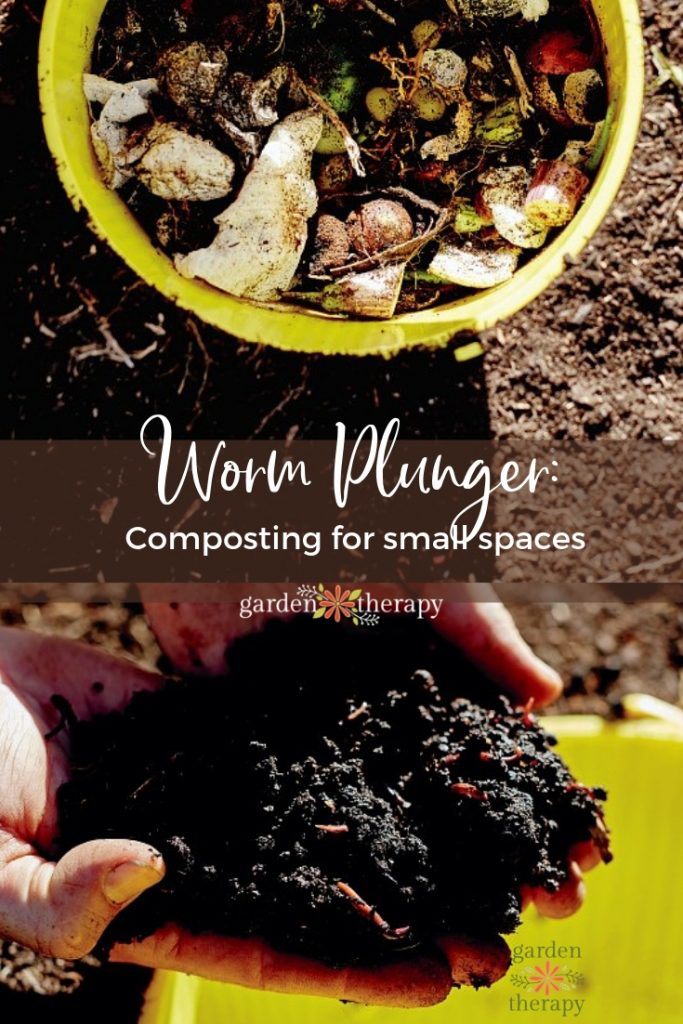
This project comes to us from Mat Pember and Dillon Seitchik-Reardon, the authors of THE LITTLE VEGGIE PATCH CO. DIY GARDEN PROJECTS which you can see here.
Worm Plunger: Build it and They Will Come
Conventional worm farms and composting bins are plagued by a few problems. For one, they can be unsightly, hulking objects that take up valuable garden real estate. Another issue is that pests easily infiltrate them. A lot of compost bins are open at the bottom, which means that any motivated rat with a little initiative need only to dig a couple of centimeters to reach a sumptuous vegetarian buffet.
Such nefarious activity was, in fact, a cultural highlight in a previous sharehouse. There, my housemates and I used to gather around the kitchen window every evening and watch a pair of rat bachelors fight it out for nightly control of the compost bin. Oh, how I miss Scabs and Snaggletooth…
Rather than building rat colosseums, we prefer to build worm apartments, and so the idea for the worm plunger was born. A worm plunger is nothing more than a plastic bin or bucket buried underground, which, so I’ve heard, is where worms like to live. We drill holes in the walls of the plunger to facilitate movement and it has a cap, which can be removed to add compost.
While this small garden composting system is not as large as a conventional worm farm, it has the benefit of being both discreet and difficult to infiltrate. The added benefit of being underground is that temperatures are normalized so worms will be at their most productive. Once it’s full, you can either remove and spread the worm castings around your patch or simply slide the bucket out of the ground and move the infrastructure to another part of the garden.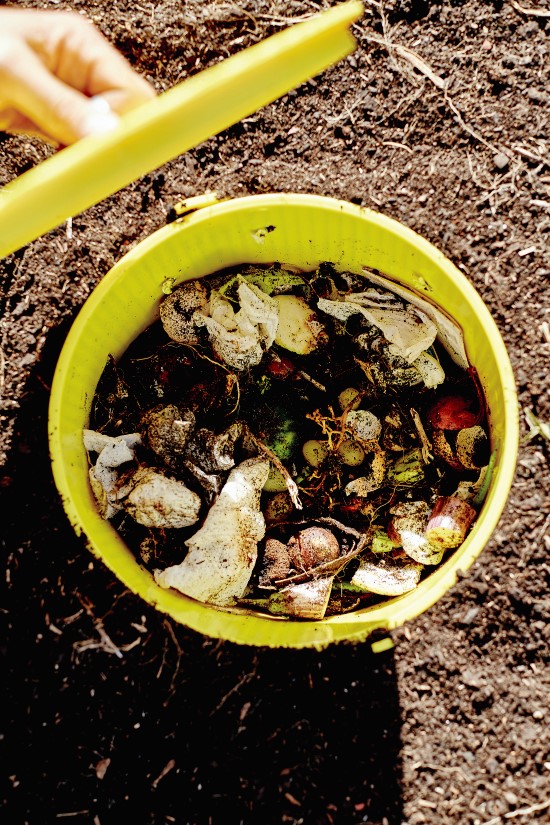
Materials
- Plastic rubbish bin or bucket with lid
- Handsaw
- Drill set
- 2 x 15 mm (½”) screws
- Bracket
- Shovel
- Compost or potting mix
- Tiger worms
- Vegetable food scraps
Make it!
Start by finding a suitable place in your patch to colonize. The worms will drastically improve the soil quality in the area so try a particularly unproductive spot in need of reinvigoration. This unit can be thought of as an overflow when your compost bin is full – or the primary unit if you are particularly strapped for space, or if rats are a genuine concern.

Any old bin or bucket will do, provided it has a lid. We found this plastic bucket at the shop and it looks like it was purpose-built for our cause. Start by sawing off the bottom.
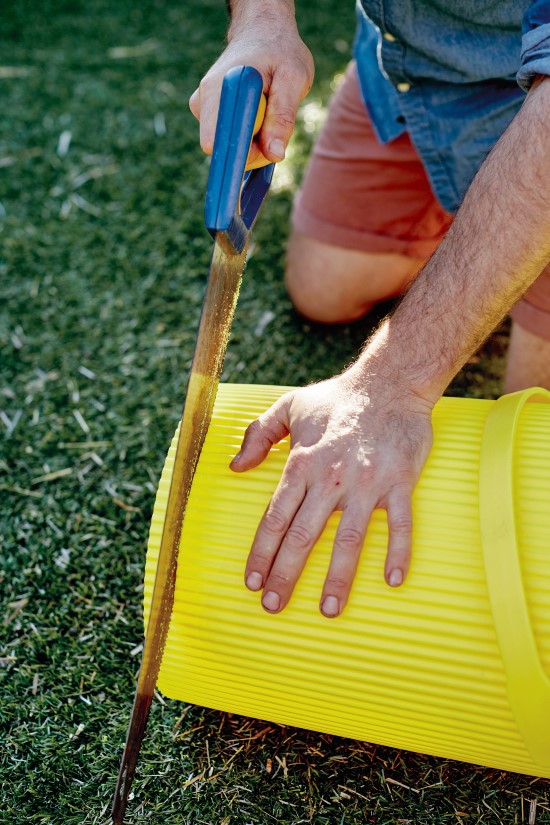
Drill plenty of holes into the sides of the bucket. These will be entryways for the occupants of this underground city. Studies of urban transportation systems have shown that improving service is the only way to increase usage of public transport, so ensure there are enough holes so no worm has to queue for too long.
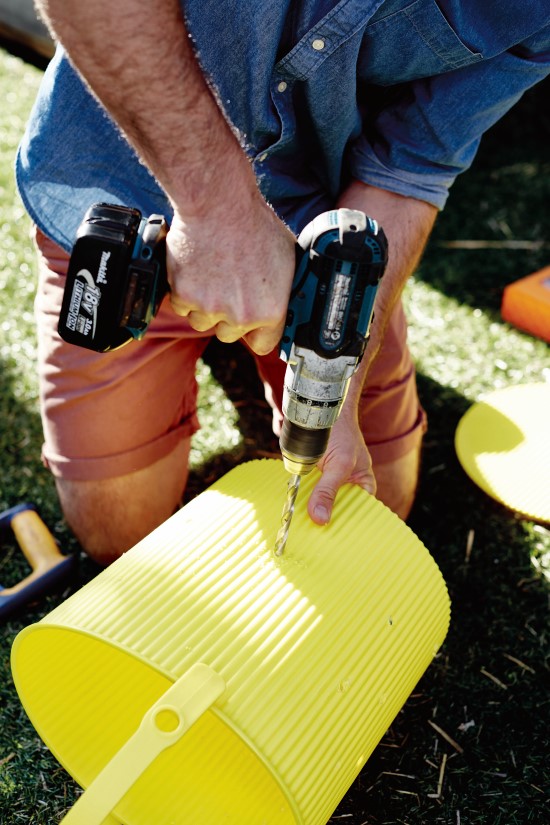
Screw a bracket to the lid to make a simple handle.
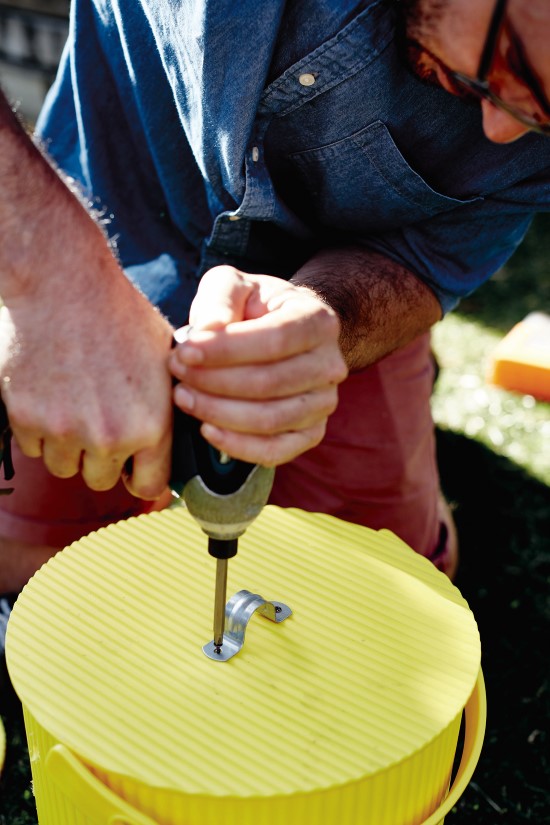
Dig a hole just deep enough that the lid will sit flush with ground level. Place the bucket in the hole and backfill the area around it. There will inevitably be leftover soil, so find a home for it elsewhere in the garden.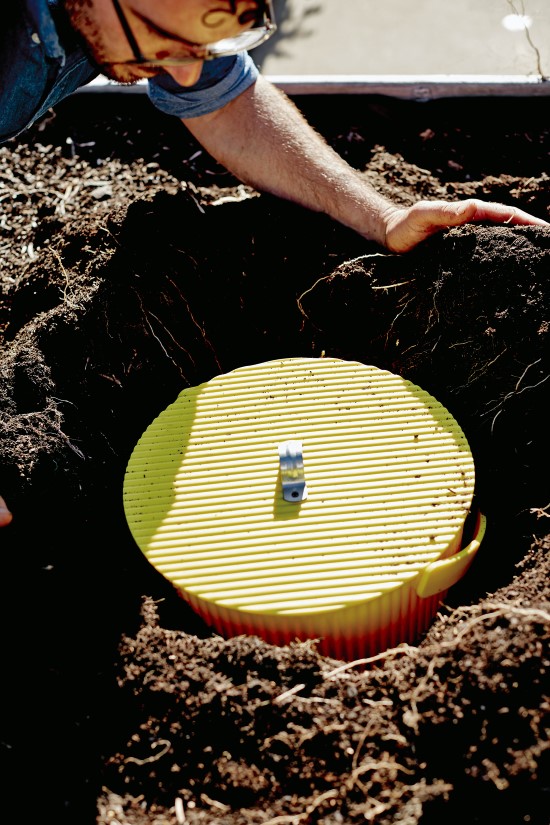
Transfer a small amount of existing compost into the bottom of the new system. If you don’t have any existing compost, a few handfuls of potting mix will do. Until they build up some good soil, the worms will need a comfortable place to retreat into when they are not eating your kitchen waste.
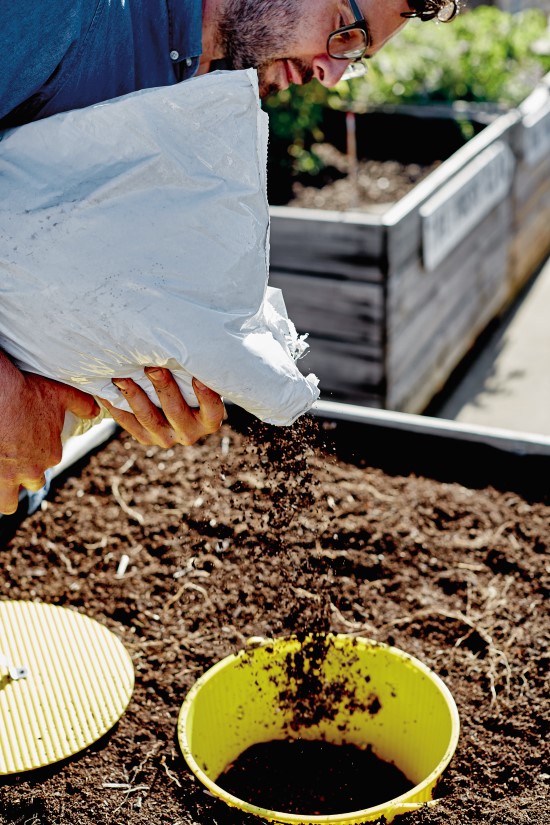
Add in the tiger worms. They are solitary, sensitive creatures but, as the name suggests, these stripey fellas are also ferocious eaters.
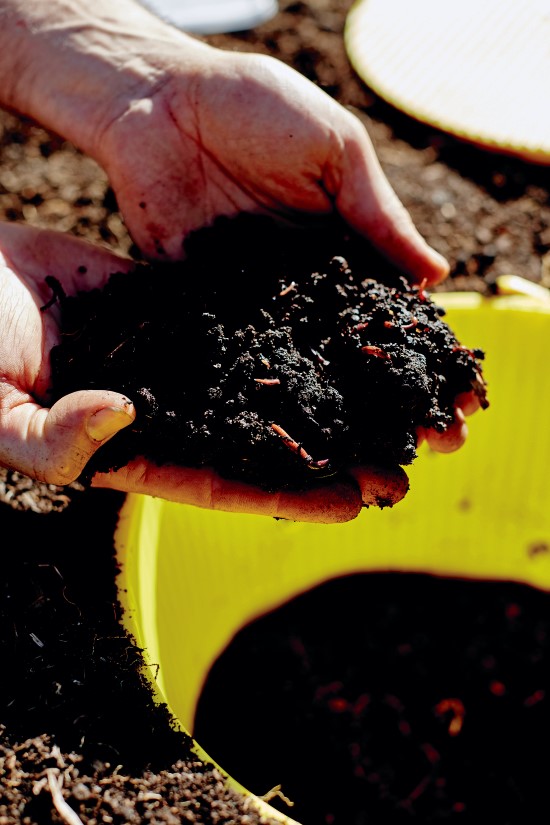
Once the worms are in place, it is time to begin your small garden composting operation in earnest. Almost all vegetarian food scraps can go into the plunger except for citrus peels and avocados, and not too much onion and garlic.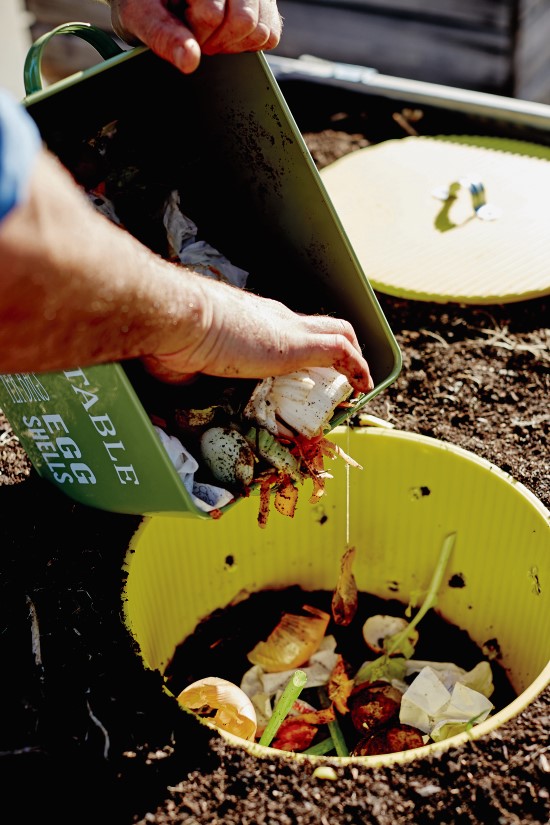
Bon Appetit!
For more smart DIY garden projects the whole family will love, grab a copy of the THE LITTLE VEGGIE PATCH CO. DIY GARDEN PROJECTS by Mat Pember and Dillon Seitchik-Reardon. It’s full of ideas for all types of gardening projects for gardeners of all ages. The reader can build ingenious box containers, garden sheds, and harvest edible green walls crafted out of inexpensive or upcycled materials. Chapters include garden basics, darling projects to do with kids, inventive options for vertical gardening, using recycled materials, seed-saving, composting, and more.
Related Posts:
- How to Do a Soil pH Test at Home
- 5 Reasons to Use a Compost Tumbler
- Give Your Plants Their Best Start with These Soil Recipes
- A Compost Recipe to Demystify Composting
- Soil Food for Greener Gardens: Find the Best Amendments in Your Own Backyard

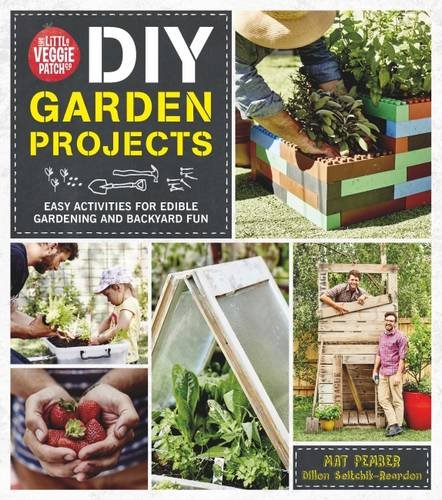



What is wrong with citrus peels and garlic and onions?
They kill off the good microbes and bacteria in your compost.
Citrus is acidic…more than the worms like. And Avacado pits and skins take forever to break down.
I wondered too!!! Dr. Gundy says avocados are a “perfect food”! very <<>> grin!!!
It appears that you put the bucket into a raised bed. True? And, If so, could we put smaller ones in each raised bed. Plant veggies around it? Let the suckers just fertilize as they go through the bed/container. Will the worms invade the “fresh stuff” growing on the plants? And, where do we get the little suckers? When I lived in the country, we had plenty to dig near the creeks, but I’m in an apartment now. Blessings!!!
I love this post!! I do believe I can handle this amount of composting! I have been trying to figure how I can use the food scraps in an efficient manner but I don’t have the capacity for ‘real’ composting in a big bin. I have some questions though:1. cant a clever rodent with ‘some initiative’ also topple the lid since in the picture it doesn’t seem to fit snuggly? 2. Should I cover the lid with something else? Also, I’m not clear on when to take out the bucket and start it somewhere else? do the worms turn all the scraps into soil? I’m a real novice at this, hence all the questions.
You can put a heavy rock on top,or use those 2 gallon buckets with lids work very good. Or use some large PVC pipe with holes in it especially if you have large rodents like raccoons or something.I like to use the two gallon buckets because they have handles and lids.
Will this work in zone 5? Can I leave the bucket in the ground?
Can this compost be used for indoor potted flower plants?
Thanks!
Compost is compost. You can make a tea if you feel more comfortable with that for inside plants. (Would not recommend if you have pets because to them it smells delish.)
Can the worms survive an Ottawa winter, do you have to replenish them yearly?